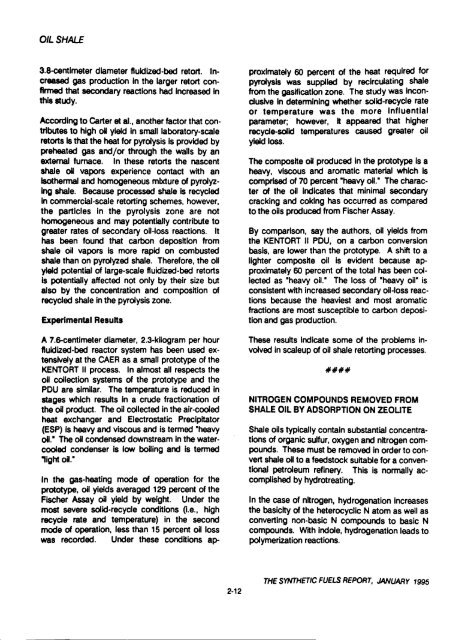Ikelic - Alliance Digital Repository
Ikelic - Alliance Digital Repository
Ikelic - Alliance Digital Repository
Create successful ePaper yourself
Turn your PDF publications into a flip-book with our unique Google optimized e-Paper software.
OIL SHALE<br />
3.8-centimeter diameter fluidized-bed retort. In<br />
creased gas production in the larger retort con<br />
firmed that secondary reactions had increased in<br />
this study.<br />
According to Carter et al., another factor that con<br />
tributes to high oil yield in small laboratory-scale<br />
retorts is that the heat for pyrolysis is provided by<br />
preheated gas and/or through the walls by an<br />
external furnace. In these retorts the nascent<br />
shale oil vapors experience contact with an<br />
isothermal and homogeneous mixture of pyrolyz<br />
ing<br />
shale. Because processed shale is recycled<br />
in commercial-scale retorting schemes, however,<br />
the particles in the pyrolysis zone are not<br />
homogeneous and may potentially contribute to<br />
greater rates of secondary oil-loss reactions. It<br />
has been found that carbon deposition from<br />
shale oil vapors is more rapid on combusted<br />
shale than on pyrolyzed shale. Therefore, the oil<br />
yield potential of large-scale fluidized-bed retorts<br />
is potentially affected not only by their size but<br />
also by the concentration and composition of<br />
recycled shale in the pyrolysis zone.<br />
Experimental Results<br />
A 7.6-centimeter diameter, 2.3-kilogram per hour<br />
fluidized-bed reactor system has been used ex<br />
tensively<br />
at the CAER as a small prototype of the<br />
KENTORT II process. In almost all respects the<br />
oil collection systems of the prototype and the<br />
PDU are similar. The temperature is reduced in<br />
stages which results in a crude fractionation of<br />
the oil product. The oil collected in the air-cooled<br />
heat exchanger and Electrostatic Precipitator<br />
(ESP) is heavy and viscous and is termed "heavy<br />
oil."<br />
The oU condensed downstream in the water-<br />
cooled condenser is low boiling<br />
light<br />
oil."<br />
In the gas-heating<br />
and is termed<br />
mode of operation for the<br />
prototype, oH yields averaged 129 percent of the<br />
Fischer Assay oil yield by weight. Under the<br />
most severe solid-recycle conditions (i.e., high<br />
recycle rate and temperature) in the second<br />
mode of operation, less than 15 percent oil loss<br />
was recorded. Under these conditions ap<br />
2-12<br />
proximately 60 percent of the heat required for<br />
pyrolysis was supplied by recirculating shale<br />
from the gasification zone. The study was incon<br />
clusive In determining whether solid-recycle rate<br />
or temperature was the more influential<br />
parameter; however, it appeared that higher<br />
recycle-solid temperatures caused greater oil<br />
yield loss.<br />
The composite oil produced in the prototype is a<br />
heavy, viscous and aromatic material which is<br />
oil."<br />
comprised of 70 percent "heavy The charac<br />
ter of the oil indicates that minimal secondary<br />
has occurred as compared<br />
cracking and coking<br />
to the oils produced from Fischer Assay.<br />
By comparison, say the authors, oil yields from<br />
the KENTORT II PDU, on a carbon conversion<br />
basis, are lower than the prototype. A shift to a<br />
lighter composite oil is evident because ap<br />
60 percent of the total has been col<br />
proximately<br />
oil."<br />
oil"<br />
lected as "heavy The loss of "heavy is<br />
consistent with increased secondary oil-loss reac<br />
tions because the heaviest and most aromatic<br />
fractions are most susceptible to carbon deposi<br />
tion and gas production.<br />
These results indicate some of the problems in<br />
volved in scaleup of oil shale retorting processes.<br />
####<br />
NITROGEN COMPOUNDS REMOVED FROM<br />
SHALE OIL BY ADSORPTION ON ZEOLITE<br />
Shale oils typically contain substantial concentra<br />
tions of organic sulfur, oxygen and nitrogen com<br />
pounds. These must be removed in order to con<br />
vert shale oil to a feedstock suitable for a conven<br />
tional petroleum refinery. This is normally ac<br />
complished by hydrotreating.<br />
In the case of nitrogen, hydrogenation increases<br />
the basicity of the heterocyclic N atom as well as<br />
non-basic N compounds to basic N<br />
converting<br />
compounds. With indole, hydrogenation leads to<br />
polymerization reactions.<br />
THE SYNTHETIC FUELS REPORT, JANUARY 1995















![pace SrntfletIc fne]its report - Alliance Digital Repository](https://img.yumpu.com/10493335/1/190x245/pace-srntfletic-fneits-report-alliance-digital-repository.jpg?quality=85)
